Back in September of 2020, readers of Wargames Illustrated were treated with a free ruleset cheekily called “Never Mind The Billhooks”. Centered on the Wars of The Roses, it soon became a very popular ruleset, with a low barrier of entry to start in medieval England. Two years on, the Deluxe version hit the virtual shelves. Updated and with new theatres to explore, the hype continues. We asked Andy Callan, author of the ruleset to answer some questions about the latest edition.

GH HISTORICALS: In general, Billhooks reminds us a bit of the Saga rulesets or some of the Osprey range in the number of models you need. Smaller projects that don’t take up a lot of time.
It’s doable isn’t it, I mean back in the day, the way you played War Games was you had to have hundreds and hundreds of figures on the table. I mean I still play games like that, but you know, who’s got the time because the standards have gone up, you haven’t got the time to paint armies like that, it would take years! Whereas this is doable within a few months so that’s the attraction. My early play testing was done using Lord of the Rings stuff and I used them because it’s before I had my War of the Roses figures. so you know anything goes really, when you’re getting started the main thing is to play the game and get used to the mechanisms and then that acts as a spur to finish the proper stuff
GH HISTORICALS: So you mentioned that you play the big games, is that something that you started out with when you started playing?
Well I’ve been playing war games for well over 50 years now, and when we all started out back then there wasn’t much available on the market. I mean everybody had boxes of Airfix figures and they were very cheap, I used to buy them from the local Woolworths. You used to have hundreds of them and everybody started with the American Civil War because the sets came in blue and gray plastic so you didn’t really have to do much to them just paint the muskets and the faces and that was it! (laughs) So big armies with badly painted figures was the way it used to be, but now it’s smaller armies with very well painted figures. The figures in the magazine and online are way beyond the standard I could ever aspire to, but that’s the way it is now and that’s a positive thing! I still play big games with old wargamers and with old armies and you know that’s another that’s another side to the Hobby really.
GH HISTORICALS: You also wrote a war of independence ruleset?
That was about 35 years ago or something like that, in the first issue of Wargames Illustrated so I have a long history with them.
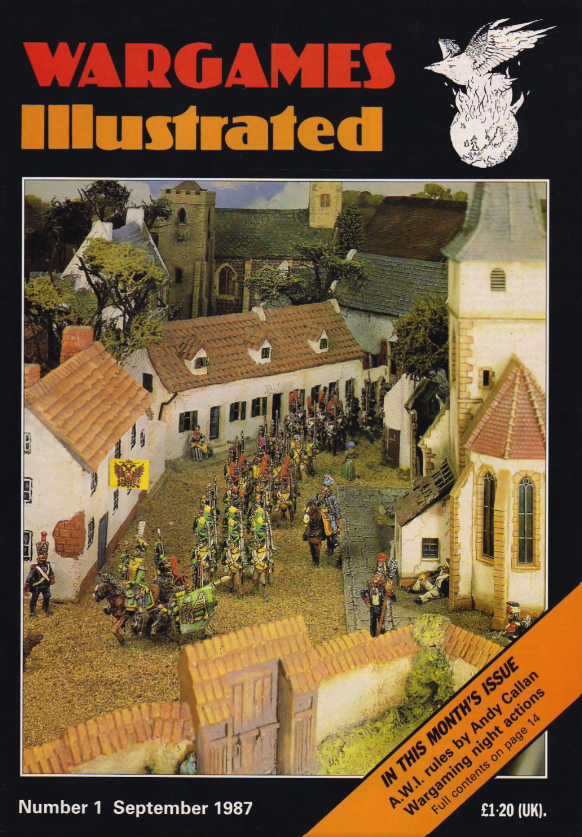
GH HISTORICALS: How did you get started with the ruleset?
There’s a few medieval skirmish or big skirmish rule sets out there that I’ve played and been dissatisfied with so I thought, write your own mate! You know, come up with something, can you do any better? So that’s what I set myself to do and it’s gone from there really.
So the incentive to write the rules was that I missed a war of the roses or later medieval ruleset. I’ve written rulesets for every period you can think of over the years, well I’d done one Wars of the Roses set already for a series of books with the illustrator Peter Dennis for Helion. They produce a Paper Soldiers series and the deal was you got your book of Paper Soldiers that you could photocopy and cut out and included in the book was a set of rules. War of the Roses was one of those, so I knew a bit about the period already.
But this was a different approach really. They’re two completely different sets of rules but I was still bringing what I knew about the period to it, at just at a slightly different scale or level really. Also an accurate War of the Roses battle game would be very very boring, because the battles were pretty boring really! You just had two big crowds just sort of rush into each other and scrapped about a bit for a couple of hours and then one side or the other won. There wasn’t weren’t really any tactics in it as far as I can see, but then nobody knows because the chronicles are very limited. And nobody tells us what happened in those battles really because nobody was paying any attention! So in Billhooks there’s a bit more going on than I think there really was in a War of the Roses battle. But if it’s pitched at this smaller scale, which I describe as a small battle or big skirmish, there probably was a bit more room for tactical things going on.
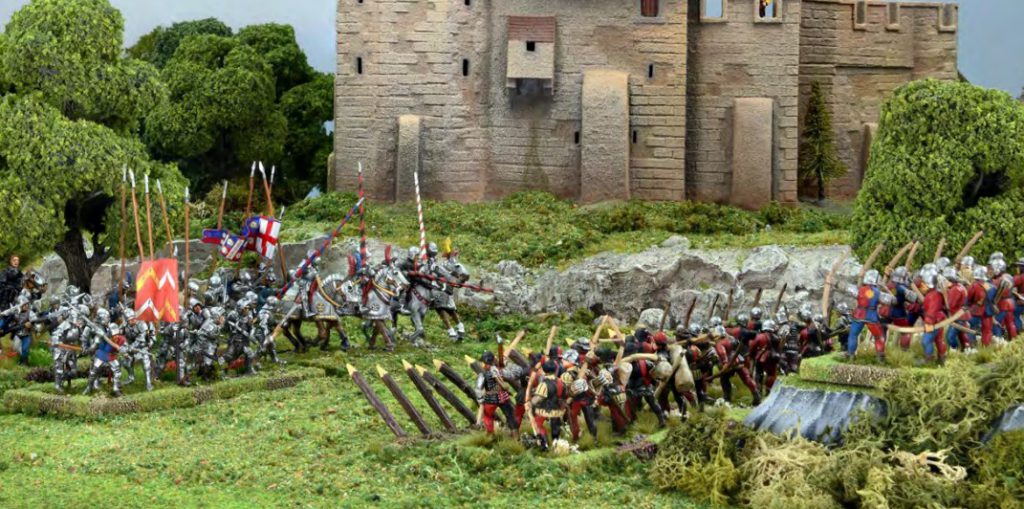
A skirmish is a very high intensity encounter, whereas a battle can be just a meat grinder you know. So that was the idea and it was trying to make something that was interesting out of a subject that probably isn’t very interesting. But it’s very colorful! I mean you can’t deny that the armies look wonderful on the table with all the heraldry and everything. And one of the things that’s always attracted me about the hobby is the visual aspect: I’m driven as much by the appearance of what’s on the table as the history really. It’s a joint thing and you couldn’t have one without the other, I think that’s like one of the things that draws people to historicals is not only the background of a conflict but also you’ve got a beautiful table with lovely miniatures. And for any people who want to put unpainted models on the table: don’t do it in public, do it in your own home, that’s fine (laughs).
GH HISTORICALS: When trying out the ruleset it felt like a real battle with initiative changing over the course of the game – it had a real flow to it
Yeah, I mean, that’s the key thing about it. It does produce a very good battle narrative, that’s what everybody finds: that they can feel it flowing like they imagine the battle would flow. And that when they come to write up the events they do sound like the events of a typical Wars of the Roses battle. And I was as surprised as anybody by that! I mean I didn’t set out to do that, it’s just the way it’s worked. It works even better than I thought it would, and I can’t exactly put my finger on what it is that works so well. I’ve got some ideas but if I knew what the formula was I’d be doing it more often! (laughs) It’s just one of those things, I’ve been writing rules for so long that somehow everything I’ve learned about rule writing has come together in this package and produced something that seems to work really well. I mean I wouldn’t claim any great originality in a lot of what it is. What it does do is, it takes a lot of well-established existing mechanisms from other rule sets, and sort of mixes them together in a new cocktail with a few little additions of my own. It produces something that people say “oh this tastes good”.
GH HISTORICALS: It feels familiar in some places but it also feels and plays really lean. You play a couple of games and you’ve got the basics down, and you can start experimenting with list building and tactics on the field.
Yeah so it feels natural, it’s pretty instinctive. Once you’re a few turns into the first game, you pick it up really because there aren’t any mechanisms that are really unusual. People will go “oh yeah I recognize that from that and that’s a bit like such and such”. But the main thing, or I think, the main attraction of it is, is that both players are doing something all the time. It’s not the sort of game where one player moves all his troops, then he shoots all his troops, and then he fights with all his troops, then he does morale tests for all his troops, and then, half an hour later the other player does something. In this you’re switching back and forth back and forth all the time within the same turn and maintaining an interest in it for both sides.
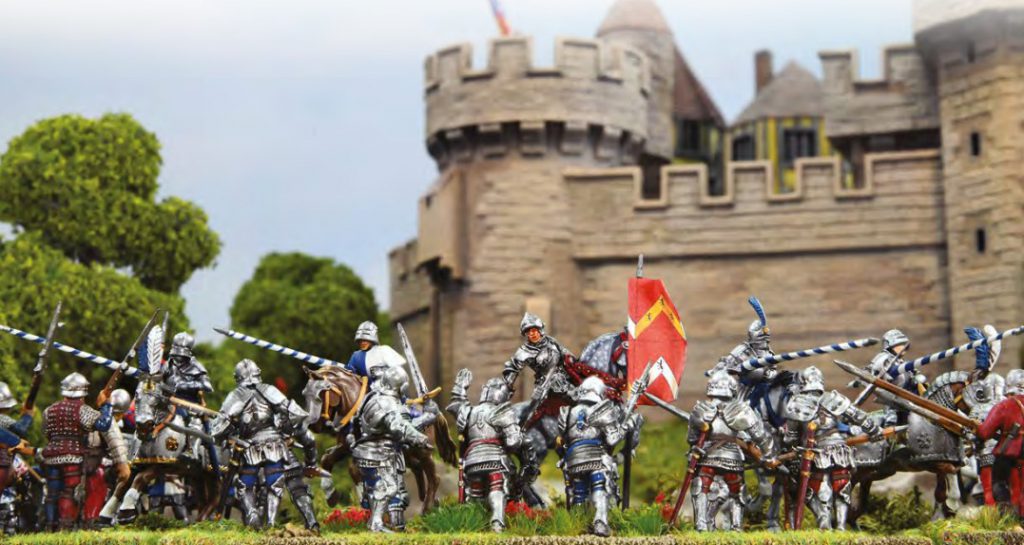
GH HISTORICALS: I think the days of the traditional IGOUGO are more or less over now, hopefully. Were there any ideas you wanted to alter for the deluxe edition?
Well it worked straight out of the tin the first time, so I didn’t see any need to change anything fundamental. There are a few improvements in wording, because of course once you put a publication out to the world the players are going to read your words in different ways. And it’s only when you’ve set it out in front of people that you realize “oh yeah I didn’t mean that but I can see how people think that’s what I meant”. So there have been many improvements in wording, and expansions in the wording. But the key mechanisms are exactly as they set off, with a few tiny little changes of course. The differences is in each of the chapters of the book. We introduce new troop types and certain new tactics for each of the new periods and theatres and things like that but using all of the core mechanisms.
GH HISTORICALS: Looking at the periods you cover, was there something specific you wanted to add or fans of the first edition were clamouring for?
Well, even when I was writing the original set I thought “well this would probably work as well for the 100 Years War or possibly the Swiss-Burgundian Wars” and things like that, so it was a natural progression really. Within about six weeks of the first publication I pitched the idea to the editor at Wargames Illustrated and said, “well look there’s a lot of interest in this, and if I don’t produce rules for the new periods other people will. And they may get some rules wrong or they may break the game by introducing new things”. So what we did instead was I put a call out on the Facebook page saying this is what we were going to do, and is there anybody out there who wants to contribute a chapter? So I got quite a few replies from people all over Europe. I’ve got a guy from Portugal, I’ve got a guy from the Czech Republic, I’ve got someone from Scotland, I’ve got somebody from Ireland… So in the end there were five other authors apart from myself, and each did their own chapter and play testing. There was a constant back and forth of various versions of each chapter to me as a sort of central backstop, because I exercised a sort of rules writers ultimate veto over everything that came in. Saying things like “well look you know this is a good idea but I think you’ll find this might just break the system if we don’t change it slightly”. So that’s what took the time really, the writing probably took four or five months, it was the editing that was the big thing. Working with the magazine and the team there to turn what six different people have produced into a coherent consistent format. And of course there was a small matter of a major world pandemic in the middle of it that delayed everything but we’ve all had to cope with that.
The original rules were produced as a supplement to a magazine, and that was the first time Wargames Illustrated had ever done that, so we did have some experience of working together on that. That showed that I could deliver things on time and you know, be relied upon to answer emails, basic stuff like that. Of course the book is the first book they’ve ever produced as well so I’m sure that it won’t be the last. They’ll probably go again with another one because it’s been quite successful for both sides, and it was a learning experience and very positive. I got a good working relationship with the team there and we fed off each other so it worked very well.

GH HISTORICALS: I think you’ve started a new tradition there because the January issue had Thalassa with some nice trireme combat!
Yes, they showed that the supplement idea could work, so I think it’s done wonders, it certainly helps sales along, and it’s something people look forward to with the magazine. It’s not going to happen with every issue, but every three or four issues they’re doing something special so that’s good. They’ll be doing some extra things like that with me for Billhooks as well. In the June issue there’s going to be a supplement about medieval Naval Warfare and that’s going to be called “Never Mind The Boat Hooks”, and it uses very many of the same mechanisms but with big 28 mm scale ships. And also lots of figures and that’s very colorful. Anybody who’s played the land version will adapt very easily to the naval version because basically each ship will be like a ward or division. You have about four or five ships a side with some little vessels skirmishing in and out and ferrying reinforcements back and forth. It’s got cards and special events and that sort of thing so it’s an easy adaptation. And then later in the year something I’m working on at the moment will be a fantasy version. Which will probably be called “Never Mind The Balrogs” possibly or even Warlocks or something like that (laughs) It will be a generic fantasy version, I’m not going to tie it to any particular fantasy world. But it’ll basically be the Billhooks mechanisms with lots of added chrome. It’s going to have magic and monsters and heroes and that sort of thing, but again, it will be very familiar to anybody who’s played the original game .
GH Historicals: That was actually one of the questions we had, which direction you’d like the ruleset to explore, fantasy is coming out of left field here.
Andy: Again, it’s one of these things where if I don’t do it somebody else will. In fact somebody‘s already working on it. A lady in Florida is doing a Lord of the Rings game using Billhooks rules and that obviously is going to work easily you know. In fact I’d already done a little bit of work on a simplified version of it for my grandsons, just to use these Lord of the Rings figures I had. But this prompted me to take it a bit further and it’ll be like an additional chapter for the Billhooks Deluxe book, Fantasia and that’s what it will be called and it’ll be in the same format as the chapters in the book. So you have the basic rules that stay the same except where there are new additions and fine tunings. So that’ll be later in the year hopefully.
GH HISTORICALS: Are you planning to leave the continent as well sometime in the future?
There are other people working on this, some of the other contributors to the book are already looking at other periods. Probably in the next few months there will be a crusades version, maybe samurai, but that’s possibly pushing a bit far. It’s basically a Eurocentric game because all of the cultures share similar military attitudes, if you were trying to take it up against Mongols or something I don’t think that would work as well, because they’ve got a whole different approach to the whole thing. But I’ll wait and see what people come up with, I wouldn’t want to push it into any later periods because basically it’s for a period where armies don’t have a proper command structure. They might have a titular head of the army, but it’ll be made up of a collection of very individually minded warlords or Lords or Aristocrats of some kind. They aren’t necessarily going to be pursuing the same objectives so that’s the difference really. Once you get more organized armies with proper chains of command, the system wouldn’t work. People will try and do it I’m sure, but I don’t think it’s appropriate.
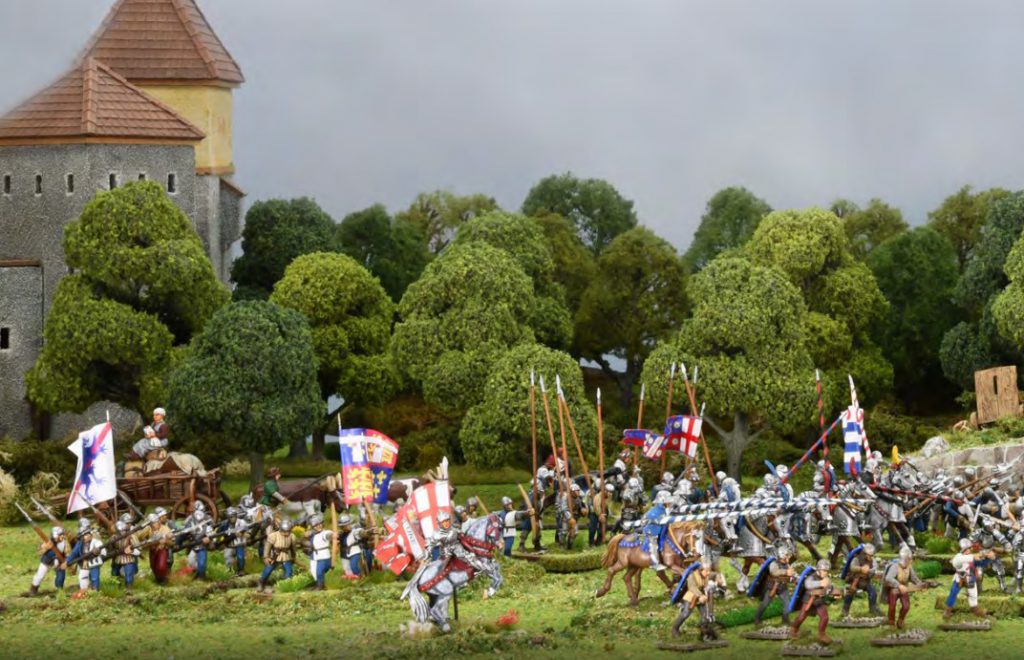
GH HISTORICALS: when you wrote the rules, what inspired you? Anything you’ve read or watched? Did you go back to those sources when writing the Deluxe edition?
Andy: The great thing about this period is that there aren’t really any historical sources. People like to think there are, but because nobody gave any detailed descriptions of what happened in the battles, we don’t even know where they were! I mean the Battle of Bosworth, they’ve had a battlefield Center built there 35 years ago and they’ve just had to move it because archaeologists decided that the battlefield was two miles in a different direction. We don’t even know where the battles were, let alone what happened, only in very, very fragmentary accounts in the chronicles. But the chronicles weren’t really interested in what happened, they were more interested in who was there. It’s a bit like writing up a society column in a magazine, saying so and so was there. They don’t really know what happened in the course of the event. The most important thing was recording who’s there and who was dead, that’s what the heralds did. I’ve got a whole library here of various original source material and I’ve gone back to what there is. But basically all background for wargames is based on the game designer’s own interpretation of what actually happened. Nobody knows for sure which is very disconcerting to a lot of people. They like to be able to say “well this is how it happened” or ”they were wearing this particular type of uniform or using this particular type of weapon”. Well yeah, maybe but most of the time they just turned up with whatever they could lay their hands on. And it can be disconcerting with people, you know people are saying “how did this work and do you know what happened when archers did this”. And I say “no mate nobody knows your guess is as good as mine”. Well it probably isn’t as good as mine because I know more about it than you do (laughs). There’s only so many sources and once you’ve read them everything else is guesswork. But to go back to your question, some of the old stuff I still find very inspiring, some of the older historians, the people who used to have to spend years toiling away in dusty libraries to come up with stuff rather than just surf the Internet to come up with a few ideas. They get bad press now though sometimes, but they could certainly write! There aren’t really any movies that have got me going as far as that period goes, which is a bit unusual I suppose. But there’s some very good novels about the wars the Roses.
Historical fiction is something I enjoy actually, it’s the sort of thing I take with me when I go on holiday to read on the beach. Conn Iggulden and Toby Clements have both written excellent novels about the Wars of the Roses And of course, Game of Thrones is Wars of the Roses with Dragons so there’s another source of inspiration there.
GH HISTORICALS: before the interview we were talking a bit about the American Revolution and how that’s also a period that doesn’t have good quality movies.
Andy: The trouble is that if you had a movie about the war of independence that was honest and truthful, the movie studios wouldn’t pay to have it made! It was essentially a civil war about a constitutional issue, and the British won most of the battles but I don’t think that makes good box office really. When I wrote the set of rules, the more I read about it the more I realized that actually the Brits did win most of the battles. It’s just they were let down by the politicians at home, who didn’t give them resources to finish the job really. But that’s always true in many wars, the movie version of the war of independence is these stupid redcoats marching around through the woods and getting shot down by people hiding behind trees! Well it may have been how it was at the start but, the more it went on the more the Brits were a much more dangerous opposition and Washington’s job was to avoid fighting them. Because he didn’t want to fight them, except on the most favourable of terms because if he did he knew he’d lose. I mean the big decisive thing was Yorktown with the help of the French and the French navy so again that doesn’t make box office does it really?
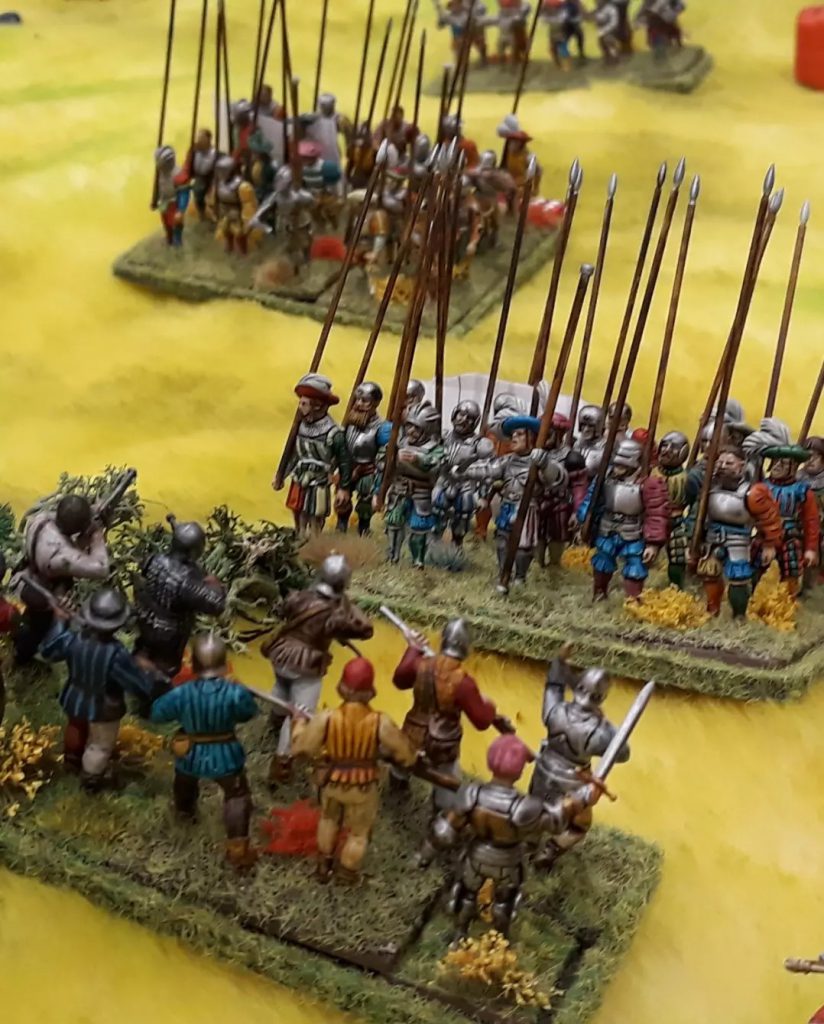
GH HISTORICALS: are there any other conflicts you want to explore, not necessarily in a Billhooks setting?
Andy: Well, I’ve been doing this for 50 years and there’s no period of warfare that I haven’t done at one time or another. From ancient Egypt to Vietnam, I’m just cycling around really and coming back to things that I did 20 years ago, and thinking I’m not very happy with what I did there, I’ll rework that. I’m a bit stuck with this Billhooks thing because it’s been so successful, oh well (laughs) Not in Warhammer fashion of course, but it’s successful in its own small way. It is occupying a lot of my time, there’s always something coming up on the Facebook page that’s keeping me busy. There’s these extra projects, so I’ve probably been less productive in terms of new rule sets over the past three or four years than for the last 20 years. But it’s producing things for a public audience rather than just a private audience. What I’ve always done in the past is write rules that are played by a small group of friends. I’ve been writing the rules, and somebody else paints the figures, or makes the scenery. But it’s a whole new ball game producing something for a public audience. The wording has to be much more precise, you have to spell things out and cover everything. It’s a much more labor-intensive process than just producing a small set of rules on three or four pages and then just winging it really, when you don’t know the answer to a particular question. I mean it’s enjoyable because as I said before people come up with interpretations. So it’s keeping me busy!
GH Historicals: are there any models you would recommend?
Andy: There are a lot of figure designers and manufacturers out there but in terms of quality and value for money I think the Perry 28mm Plastics really stand out. Of course the advent of 3D printing is going to be a real game changer so who knows where we’ll be in a few years’ time?
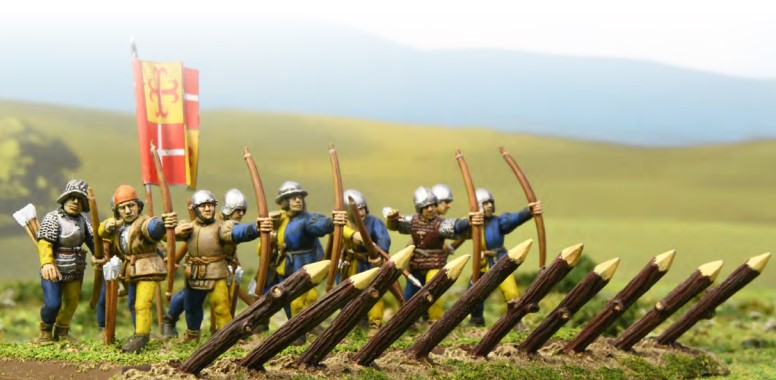
As far as the Billhooks rules go, there will be a lot coming out in the months ahead in Wargames Illustrated. They have just set up a dedicated website www.nevermindthebillhooks.com which brings together a lot of resources. And of course for discussions of anything to do with the game and showcasing figures there is always the Never Mind the Billhooks Facebook page, which I will continue to keep a close eye on.
GH Historicals: Thanks very much for your time and the chat Andy!
We can only recommend Never Mind The billhooks Deluxe if you want to start out in the medieval period. We’re on a bit of a binge with the period at the moment, so grab a copy and put some knights on the table!
Have any questions or feedback? Drop us a note in the comments below or email us at contact@goonhammer.com.


